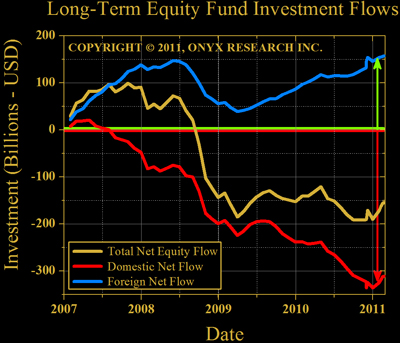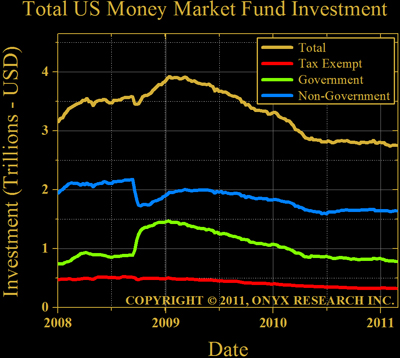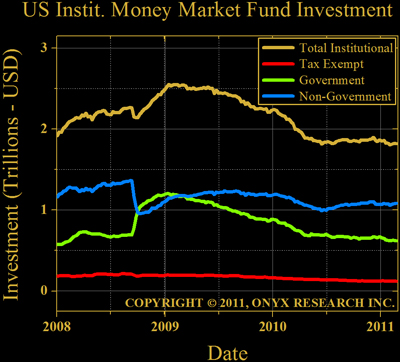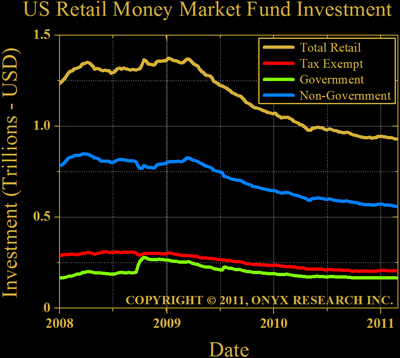_October2013_small-c5284e74ed9ef79f612813617b47061d92bf282e0f0f8ff07179efcb1aa8cc1a.jpg)
|
Research & Analysis for Business and Investment Clients |
|
This flow is small when compared to the net long-term fund value exceeding $8 trillion USD.

Figure 7. Net Long-Term United States Equity Fund Flows Since 2007. Net flows since 2007 are negative. Foreign flows, however, are positive.
Total United States Investment in Money Market Funds
Money market capital is used to invest in assets like commercial paper, pay near-term liabilities, or hold cash equivalents that accumulate with retirement contributions from plan participants. Cash typically devalues, encouraging institutions hold money market assets yielding modest positive returns.

Figure 8. Total United States Money Market Investment Since 2008. Approximately $3 trillion USD is held in money market funds. The government cash injection in late 2008 is clearly evident. Private money decreased, but was buffered with government investment.
Investment data indicate the government is working successfully to stabilize market fluctuations. Aggregate values can be further split into institutional and retail investor pools. Institutional investors often have access to more industry data and better information networks.
Routinely, institutional investors move money before retail investors. As a result, it is instructive to see whether institutional money shows unique trends.
United States Institutional Investment in Money Market Funds
Figure 9 plots institutional investor data for government, non-government, and taxable investments. Excluding the government injection in 2008, funding levels look stable.
 Figure 9. United States Institutional Money Market Investment Since 2008. The red curve plots non-taxable investment. The green curve plots government investment. The blue curve plots non-government investment and the gold
curve sums the asset class.
Figure 9. United States Institutional Money Market Investment Since 2008. The red curve plots non-taxable investment. The green curve plots government investment. The blue curve plots non-government investment and the gold
curve sums the asset class.

United States Retail Investment in
Money Market Funds
Retail investment dynamics look different (see figure 10). The government contribution is modest (why it is non-zero is unknown), while the non-government contributions have a steady outflow beginning in early 2009.
A hypothesis for the outflow from cash equivalent assets could be: Retail investors are seeking a higher return. Slightly higher returns can be found in bonds, which are perhaps safer than equities. The outflow and inflow match in magnitude (~$500 billion), but we cannot determine where the long-term bond money originated.
 Figure 10. United States Retail Money Market Investment Since 2008. The red curve plots non-taxable investment. The green curve plots government investment. The blue curve plots non-government investment and gold
curve sums the asset class.
Figure 10. United States Retail Money Market Investment Since 2008. The red curve plots non-taxable investment. The green curve plots government investment. The blue curve plots non-government investment and gold
curve sums the asset class.
Summary
Data indicate municipal and state liabilities are currently small enough that the system can absorb liabilities gracefully. Looking forward, a watchful eye must be cast on potential liability expansion.
A key public worker benefit difference, not enjoyed by the private sector, and emphasized by Mayor Bloomberg, is the way payments to public sector retirees are committed.
Private sector workers currently make contributions to plans such as 401(k) and 403(b) retirement accounts. Public sector workers, however, are guaranteed retirement benefits. As a result, public sector workers benefits scale with the market prices for goods and services (inflation cannot dilute goods and services commitments). In addition, life expectancies and healthcare costs expand worker benefits.
A justified concern, then, is that the public sector commitments could grow significantly.
Thankfully, it is unlikely public sector workers will retire en masse. This means the system can adapt and innovate to accommodate growing healthcare and benefit commitments. This statement assumes employers have a workforce with distributed age. To understand a given municipality or state, it will be important to consider work force age distributions.
Conclusions
The sky is not falling. Expect states and municipalities to move forward with business as usual.
At the Federal level, however, chicken little is justified. The United States deficit is Big.
Looking for knowledge unique to your needs? Click on the Onyx Premier Black icon below.

Mutual fund data adapted from the Investment Company Institute® (ICI)
